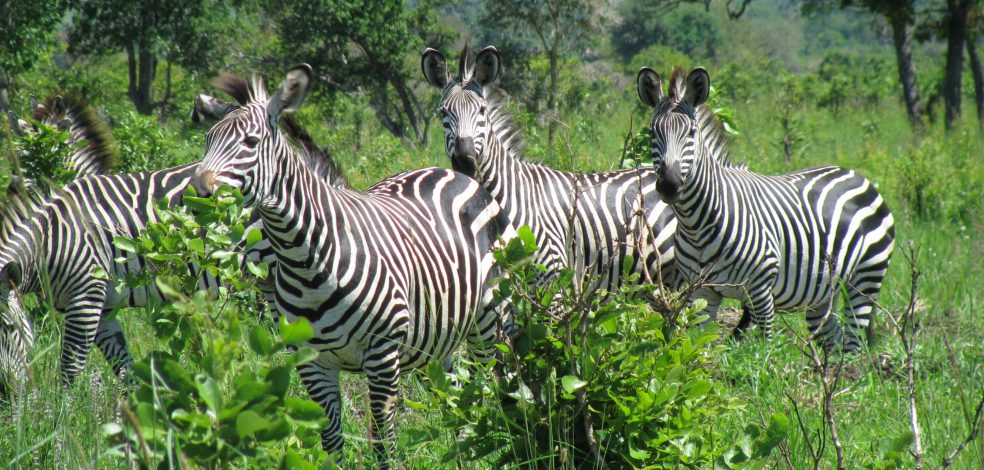Humans and lowland gorillas (Gorilla gorilla gorilla) share many features, including strong social bonds among members of their group. Lowland gorillas differ from humans in that one male (the silverback) dominates the group, which is composed of several females and their offspring. Some mature males are unable to attract females and may be consigned to a solitary existence. The silverback male mates with females in his group, and may allow other females to join. However, if a female joins a new group with an unweaned child, there is a high probability that the silverback will kill the child, as a way of getting the female into estrous more quickly, so that he can be the father of more future children.

A group of gorillas ranges over the landscape. Credit: Céline Genton CNRS/University of Rennes
The Odzala-Kokoua National Park in the Republic of Congo is home to several thousand lowland gorillas. Nelly Ménard and Pascaline Le Gouar (in affiliation with the ECOBIO laboratory CNRS/University of Rennes) have been studying two populations of these gorillas for over 20 years, and have identified and collected long-term data on 593 individuals from the two populations in their study. Working with their student, Alice Baudouin, and several other researchers, they documented that about 22% of the individuals were suffering from a yaws-like disease – an infectious skin disease caused by the bacterium Treponema pallidum pertenue.

A mother carries her infected infant. Credit: Ludovic Bouquier CNRS/University of Rennes
Females may disperse from their social group several times over the course of their lifetime. Factors influencing the decision to disperse include availability of a higher quality silverback, reduction of predation, and avoiding inbreeding, resource competition and disease. Given the prevalence and conspicuousness of yaws, the researchers suspected that these highly intelligent animals would use a variety of cues to inform them of whether they should disperse and which group they should attempt to join. They expected that females should leave diseased silverbacks for healthy ones, that they should leave groups with numerous diseased individuals and immigrate into groups with healthy individuals, and that diseased females would be less likely to leave their group. Other factors influencing a gorilla’s decision might include group size, group age and whether she had an unweaned infant in her care.

Silverback gorilla viewed from the mirador (observation post). Credit: Céline Genton CNRS/University of Rennes.
Because they considered so many variables, the researchers used their dataset to construct models of the probability of emigration (leaving the group) and immigration (entering a new group). The research team categorized each breeding group based on the age of the oldest offspring: young (oldest offspring less than 4 years), juvenile (<7.5 years), mature (<11 years) and senescent (< 14 years). Female gorillas were more likely to emigrate if their group had numerous infected individuals (graph a below) and if the silverback was severely infected (graph b). They were also more likely to leave an older breeding group, perhaps understanding that the silverback would be losing effectiveness in the near future (graph c). Lastly, females with unweaned infants were very unlikely to leave a group (graph d), presumably unwilling to accept the risk that their infant might starve or be killed if they attempted to join a new group.

Probability an adult female emigrates from her group in relation to (a) number of severely diseased individuals within her group, (b) presence of severe lesions on the silverback, (c) age of the breeding group, and (d) presence of an unweaned infant. Dotted lines (in graph a) and bars (in graphs b, c and d) indicate 95% confidence intervals.
The research team did a similar analysis of factors associated with female gorillas immigrating into a new breeding group.

Probability an adult female immigrates into a group in relation to (a) age of group, (b) presence of severely diseased individuals, and (c) group size. Bars (in graph a and b) and dotted lines (graph c) indicate 95% confidence intervals.
They discovered that females were much more likely to join younger groups which had younger silverbacks (graph a). In addition, females tended to join groups without any severely diseased individuals (graph b). They were also attracted to smaller groups (graph c).
Based on these data, it is clear that disease strongly influences female dispersal decisions. Females were much more likely to disperse from breeding groups with numerous infected individuals, and strongly avoided groups with more than two diseased individuals. This is not surprising, given how conspicuous these skin lesions are, particularly in the facial regions. Contrary to expectation, female disease status (infected or not) did not influence female dispersal tendency. The researchers suggest that dispersal might not be particularly costly to the female (assuming she does not have an unweaned infant) because the home range of social groups overlap broadly so it is easy to move from one group to another, and food is also plentiful throughout the range.
Many features of a gorilla’s social environment influence its dispersal decisions. Because diseased females are as likely to disperse as healthy females, the disease pathogen may be more easily spread into previously uninfected gorilla populations. On the other hand, dispersing female avoidance of diseased populations has the effect of quarantining the diseased populations. The researchers hope to get a better understanding of the mechanisms of female appraisal of their social environment, so they can predict changes in the prevalence of this pathogen.
note: the paper that describes this research is from the journal Ecology. The reference is Baudouin, A., S. Gatti, F. Levrero, C. Genton, R. H. Cristescu, V. Billy, P. Motsch, J.-S. Pierre, P. Le Gouar, and N. Ménard. 2019. Disease avoidance, and breeding group age and size condition the dispersal patterns of western lowland gorilla females. Ecology 100(9): e02786. 10.1002/ecy.2786. Thanks to the Ecological Society of America for allowing me to use figures from the paper. Copyright © 2019 by the Ecological Society of America. All rights reserved.
